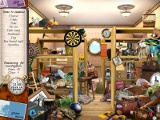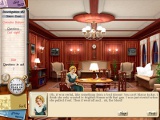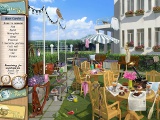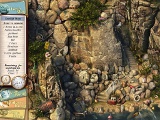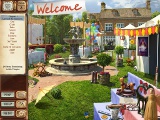





Laura Jones and the Legacy of Nikola Tesla (demo)
This is a game I only found at Acer GameZone, although it may have turned up
at Oberon's site since. There are several Laura Jones games, following what
looks like a nine-year-old girl and her pet possum on their adventures, but from
the irritating voiceover and the equally irritating bag full of junk plus
cellphone that I'm supposed to rummage around in, I gather that Laura Jones is a
teenage bimbette, to make it worse: from America. Why this is bad is that she
has gone to her grandmother in Europe, that faraway fairyland (from the target
demographic's point of view) to find out about Nikola Tesla, the famous inventor
who was sooooo popular with women. Reality check: Tesla lived in the USA, was an
obscure and impoverished inventor who basically had his inventions stolen by the
FBI after he died (and by famous "inventor" Edison while he lived), and was
unlikely to ever have interested a woman; since he is rumoured to have been a
germ-phobe, I doubt he even wanted to. The game puzzles are like kiddy howtos.
Add that to the irritating main character and the falsification of history, and
I had no problem deleting this game mere moments after installing it.
The Mushroom Age (demo)
I had high hopes for this humorous time-travel game, but it has exactly the
same problems as the Laura Jones game: dumb lead,
annoying voice-over, irritating puzzles and misinformation. If you've noticed
that so many main characters in Oberon games are female: that's not feminism,
that's the eye-candy factor. Apart from characters like Faye from the Dream Chronicles games that never come into view,
characters are designed to look and act ditzy, and in case players don't realize
this is supposed to be attractive, the game itself will remind them. If Laura
Jones was a teen with the face of a nine-year-old, this lead character who acts
like a teen is supposed to be engaged. She goes to the lab of Dr. Einbock, who
is a dead ringer for Einstein, to investigate the disappearance of her fiance
(maybe he's on the run from having to marry her?) and the professor instantly
faints because this charming young woman reminds him of his deceased wife.
Brought round by the scent of lilies, he has her help him activate a
cellphone-like time machine that will transport her back and forth through time
to find the missing assistant. Whooo, travelling through time is like riding
down a Magical Colon, and it's not everyone who gets an audience granted by
Nostradamus, but every hidden objects puzzle has objects that need to be moved -
I like my scenes static, thank you - and when she cleans a T-rex's teeth and
tells it to avoid tooth decay by going vegan, my jaw drops with a clunk.
Firstly, carbohydrates are what mouth bacteria feed on, and what foods contain
carbohydrates? Exactly: vegetable-derived foods. Animals store their energy as
fat, and no matter what the other disadvantages of animal food, it won't make
your teeth rot. Secondly, the division into "do eat" and "don't eat" food, a
transparent ruse to scare the T-rex out of eating the girl, includes a flying
saucer (made of metal) on the "animal" side and a cake (presumably made
with eggs and butter) on the "vegan" side. And if cake won't rot your teeth, I
don't know what will. Game deleted!
Magic Academy
This is an older game from Nevosoft Positive Games, the company behind The Mushroom Age. Uh-oh. Still, I got as far as the oracle,
within the demo's time limit, without being offended. I can see the game is
older because the screen is fuzzy (meant for lower resolutions), and without
moving objects or voiceovers. I can also see the gamemakers were still learning
the language (a surprising number of game companies working for Oberon are in
non-English-speaking countries, possibly to keep costs down), more on that
below. The background music is soothingly generic-fantasy; I could have sworn I
was in some enchanted forest.
The story: the player, Annie, must find her sister, Irene, who disappeared
from the Magic Academy. She turns to the staff, and to Irene's friend Melamori
(who looks like Harry Potter, or Ernie Eaglebeak for those who remember the Spellcasting 101 text adventures) for help.
After running errands for people and being sent back and forth, she succeeds,
and all ends happily.
The game consists of a number of scenes, doubling as levels, each featuring a
character who gets his or her own little info card in the menu screen after
meeting them for the first time. Here I run into a little boo-boo: after
creating a new username and starting as that user, I expect the menu screen to
be pointing its arrow at the first scene (one of the windows in the academy
building) but instead it's pointed at the fifth scene, where the previous user
profile left off. The arrow is just a bookmark; it's possible to choose an
earlier scene or even a later one, although I don't know if that would mess up
the game. Going to the menu screen in the middle of a level means having to
start that level over again. Being able to redo an old level may just be a way
to get a better time; after finishing a level, if there are more users, a
fish-eye-view animation leads to a results window, showing which user was the
fastest. To avoid this stupid results box, I deleted all but one user profile.
A bigger boo-boo is the STILTED DIALOGUE!!! Not only that, but the awkward
use of language in general. In the info cards, oracle Gersinsdorf, who looks
like he has pointy elf ears, is said to be "deviant to the school rules" and
"get away with queer acts". Angela, who works in the greenhouse, says she has to
plant plants before sunset and it's already the "fag-end of the day". Either
some programmer was having fun with double entendres, or NevoSoft should have
hired a native speaker to edit all text strings. Maybe this was why the game was
dropped by Oberon after its migration to CasualGames.com, even though it was a
popular and well-known game when it first came out. I ended up buying it from
Big Fish Games. Its sequel,
Magic Academy II, is still available at
CasualGames.
Being a vintage game, it has a low resolution, looking fuzzy on my monitor
and making objects harder to find, or even identify. They are not hidden or
recoloured in quite the sophisticated way of later games, but can be tucked away
in improbable places. Possibly due to language problems (a feather quill is a
"pen", an hourglass is a "sandglass", a "bush" can be a plant or a brush, and
"mouse" refers to a stuffed mouse toy rather than the real mouse in the same
room) the list of objects to find can be in writing, or in the form of a list of
silhouettes, whose sizes can be enormously disproportionate to the object they
stand for. The game has a timer (although despite the object lists getting
longer as the game progresses, I've never run out of time), a 20 second penalty
for too many misclicks (which have a breaking-glass sound effect) and a
self-recharging hint button. As a change to the normal scenes it has
splitscreens where the player has to find differences, and each bunch of levels
is followed by an interim game, either a memory game or a rotating tiles puzzle.
If I redo a level, it is exactly the same, so I assume the whole game plays out
exactly the same each time. My favourite two levels were the ghosts, and finding
all of 43 butterflies in the greenhouse.
Haunted Hidden Object Bundle - 2 in 1:
My, my, my. The graphics of Deadtime Stories (play on
"bedtime stories") are incredible even by Oberon game standards - too bad the
game wouldn't let me make screencaps, so the left half of the game launch screen
will have to do. Ooh, that colourful clutter in the magical weed patch, the
kitchen, the basement. And the creepy background music, hoooo. Tracing the life
and death of a voodoo woman in last century New Orleans - a newspaper snippet
mentions a Germany on the verge of WWII - it is mostly ghostly chanting around
the woman's house and garden shed, the swamp and the house of the evil person
who asks for her services, but inside the pharmacy it tails off into a scarily
jazzy tune. The little upstart in the top hat is Edward Black, who has
personally designed the cemetery he invites the player into, and points out the
grave of this installment's main character, whose story will retell itself as
the player finds objects and brews potions, through cut scenes with - argh -
voiceovers. The voices are bearable and fairly authentic; still, I turn off
sound effects (which includes voices) except when solving the piano puzzle. An
evil woman, said to murder her servants, wants the local voodoo woman to curse a
newcomer for getting invited to "all the best parties". She agrees to pay a
princely sum of 150 dollars, but in the end pays only 25. The voodoo woman takes
revenge, but her revenge also means her own end. The game is full of ghosts and
spirits, and there are grinning voodoo dolls at the bottom of the game screen.
Strangely enough it was possible to capture a screen under Vista rather than
Win7, so I used a temporary Vista installation to capture the image below:
Dr. Lynch, on the other hand, is a sceptic whose reaction to all
ghost reports is "bah, humbug". Since his book sales have dropped, he needs a
new ghost story to debunk. Coincidentally, a ghost has been seen at an
excavation site near a charming Cotswolds village, where the excavators have
taken turns watching at night to find out who's behind the constant sabotage
attempts. This game's setting is very British, like the Agatha
Christie games below, making this a more relaxing game to play, even though
this game has a timer and Deadtime Stories doesn't. Also like the Agatha
Christie games, it takes the form of an investigation introduced by a drawn
comic and divided into stages, each stage followed by an interim puzzle that
gives the player an extra hint if completed. Per stage, there are several
locations to find objects in, and as the investigation progresses, the player
has less time to find everything. Neither the saboteur, nor the ghost, nor even
the local vicar are what they seem, and what should be a tense case - there are
three murders - is a delightful wandering from prehistoric standing stones to
formal garden to tea house to pub to souvenir shop, pictured below. For each
completed level, one of the characters offers some comment or insight on the
case, and they, like their surroundings, are so stereotypically British that I
was surprised by all the Russian names in the credits.
Agatha Christie Bundle - 3 in 1:
These three games, I assume adaptations of Agatha Christie novels and
featuring Belgian detective Hercule Poirot, illustrate the development of hidden
object games, though fortunately stopping short of voiceovers. The first game
(fuzzy... low resolution...) has slideshow interludes imitating cinema in the
silent film days. Suspects can be interrogated between investigations. The
investigations have several stages, with timer and several scenes to find
"clues" in, time getting shorter for each stage, and games between stages, as in
Dr Lynch - Grave Secrets. In the second game, the
interludes are crudely drawn comics and the interrogations have been replaced
with "clue cards", also as in Dr Lynch - Grave Secrets; the resolution is
higher and the graphics are more crisp. Unlike the first game, which had
oriental-flutey background music, the second game's background music is also
similarly relaxing, even though there is a murder to be solved. The third game
is exactly like the second except for two improvements: the interlude comics are
more finely drawn, and for those who have finished the game and are wondering
just how much hidden objects there are in each screen, there is a "find all"
game mode. These four games are the kind of games I play to forget about my
money troubles, although, ironically, they all center on problems caused by
(lack of) money.
In the first game, Poirot happens to be on the same cruise as
the honeymooning Linnet and Simon Doyle. Awkwardly, Simon Doyle's old flame, who
introduced him to Linnet, has come along, and it appears that, one evening, in a
drunken rage, she shoots Simon and then kills Linnet in her sleep - only at the
time of the kill, she was in bed with a dose of tranquillizer. During his
investigation, Poirot finds that almost everyone on the trip has a reason to
hate, if not Linnet herself, then her unscrupulous-businessman father. And there
is a jewel thief involved. Not only does this game convey a holiday spirit
spiced up with a little mystery, but its objects are suitably dated: if the
object list says "camera" or "radio", I know I should be looking for an old
model. Simon's "safari hunter" quarters are only outdone in colonial Britishness
by those of Poirot's English colleague.
Staying in the holiday spirit, now in the twenties and thirties,
Poirot and his chronicler are spending time at a seaside hotel on the coast of
Cornwall when a Miss Nick stumbles into view, trying to avoid what she claims is
a bee, but what Poirot finds is a bullet. She lists the coincidental near-death
encounters she's had, and Poirot suspects they are not coincidence, although
Miss Nick's best friend assures him she can be a dreadful liar. She owns End
House, a charmingly situated mansion that has sadly fallen into disrepair, and
will do anything to get the money for it to be fixed. As well as some dashing
friends, she has neighbours who claim to be from Australia. Add a local
sanatorium, and there's plenty of beautiful scenes to hide objects in.
As twentieth-century as it gets: Poirot is called by a murder
novel writer, who has been hired by a wealthy couple to organize a "murder hunt"
at their party. She has a nagging feeling that something awful is going to
happen. Poirot agrees to come, and pretends that he will be handing out the
prizes. At first sight, nothing seems wrong. The rich owner and his slightly
retarded wife, the architect employed to patch up the crumbling folly (a marble
mini-gazebo) in the woods, the dopey village girl who agrees to play the victim;
none of them seem suspicious. Of course, nothing is as it seems. Scenes for this
game: the mansion's bedroom and its front lawn, the refreshments tent, the
fortune-teller's tent, the garden of the former owner's house, the boathouse,
the yacht of cousin Etienne and, of course, the folly: pure, high-calorie
eye-candy. Finding three or four objects in a row quickly gives me an extra
hint, so in the "find all" game, I also try to collect as many hints as I can; a
hints highscore, as it were.
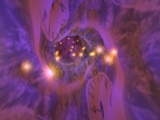
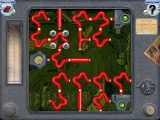

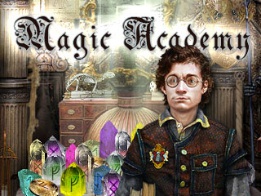
Clearly based on a popular children's book.
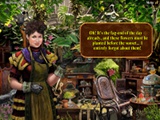
In case you thought I was joking. (Click to enlarge.)
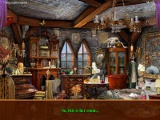
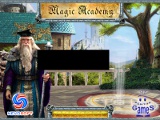
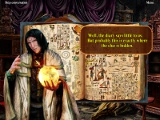
Deadtime Stories
Dr. Lynch - Grave Secrets
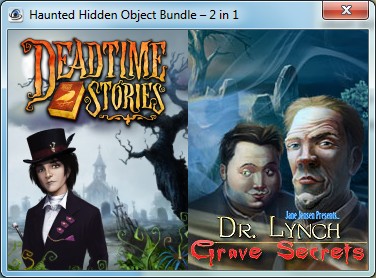
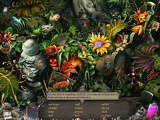
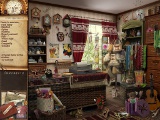
Death on the Nile
Peril at End House
Dead Man's Folly
